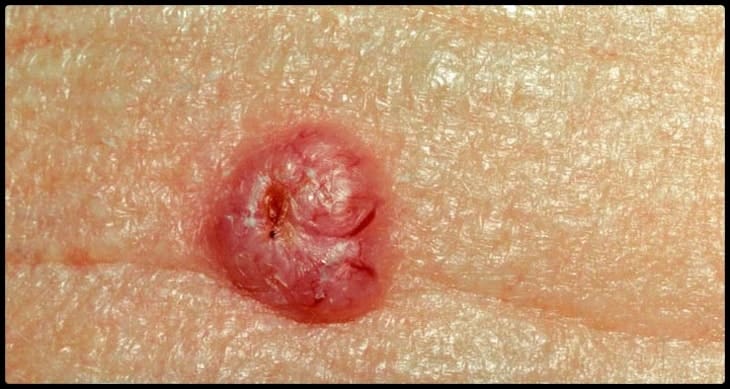Basal Cell Carcinoma
It hasn’t been scientifically proven yet; however, some people believe this increase is due to the number of people spending more time in the sun or the decrease in protection from the ozone layer.
Basal Cell Carcinomas often appear on areas of the skin that are exposed frequently; 85% located on the neck, face, or around the head. However, they can still appear on areas that are protected from the sun, such as the breasts and the groin. More often than not, it will appear as a sore or a pimple that crusts over, bleeds often, doesn’t heal, or will heal and then appear again.
Not all basal cells look alike; some may appear as a scar cyst, or a simple scaly patch on your skin. And while they do not metastasize, they spread by direction extension and are very destructive to the surrounding and underlying tissue. For this very reason, Basal Cell Carcinomas should be treated immediately after diagnosis.

Related Pages
Quick Quote
How Dangerous is Basal Cell Carcinoma?
Just as any other skin cancer you can be diagnosed with, Basal Cell Carcinoma can be treated and cured; however, if left untreated, it could become deadly. This type of skin cancer rarely spreads to other parts of the body; instead, it slowly destroys the tissue surrounding it. If these carcinomas grow near the eyes, ears, mouth, nose, or brain, consequences can become more serious and often deadly. If you are concerned about a place on your skin or would simply like to be checked out, the best place to start is by calling your dermatologist. While it may seem scary to be diagnosed with skin cancer, it doesn’t have to become serious.
Basal Cell Carcinoma Symptoms
Basal Cell Carcinomas often develop on the parts of your body that are exposed to the sun more often than others, specifically your head or neck. And while it doesn’t occur as often, they can appear on other places such as your genitals. They usually appear as a small change, such as a growth or sore, on the skin and often have one or more of the characteristics we’ve listed below.
- Pearly white, skin-colored, or light pink bump on the skin
- A brown, black, or blue lesion on the skin
- Flat, scaly patches that are a reddish, pink color
- A white, scar-like lesion that appears waxy
Causes of Basal Cell Carcinoma
Basal Cell Carcinoma begins when one of the basal cells in the skin develops a mutation in its DNA. These cells can be found at the bottom of the epidermis, the outmost layer of your skin. They produce new skin cells, pushing the older ones towards the skin’s surface, where the old cells eventually die off.
The basal cell’s DNA controls the entire process of creating new skin cells, as it contains “instructions” that tell the cells what to do. When a mutation develops, it tells the basal cells to multiply rapidly and continue growing rather than dying. Eventually, the increasing number of abnormal cells will form a cancerous tumor that appears as a lesion on the skin.
Some people often associate skin cancer with sun exposure as well, seeing as the UV rays penetrate the cells and increase the production of these abnormal cells. It’s highly recommended that you wear sunscreen any time you are exposed to sunlight for longer periods of time.
Diagnosing Basal Cell Carcinoma
While most doctors can recognize and diagnose a basal cell carcinoma by simply examining it, the most efficient way to receive a correct diagnosis is by biopsy. Biopsy’s are the standard procedure for diagnosing Basal Cell Carcinoma, as well as other skin cancers. During the procedure, your doctor will remove a small piece of the tumor and have it examined under a microscope to further examine its DNA.
During your exam, your doctor may ask you a series of questions, such as the following:
- Did you spend a large portion of your younger days in the sun?
- Have you ever experienced a blistering sunburn? If so, how often and severe?
- Do you use sunscreen when exposed to the sunlight?
- Have you ever used a tanning bed?
- Have you noticed any unusual spots on your skin that don’t heal? Do they tend to bleed?
Treating Your Skin Cancer
When it comes to removing skin cancer, there are three main goals for a doctor:
- Leave minimal scarring
- Make sure the patient has very little pain during the procedure
- Ensure it won’t come back
In order to choose the best treatment plan, your doctor will take both the size and placement of the cancer into consideration, as well as how long you’ve had it. They will also take the chance of scarring into account and your overall health.
There are several methods to treating and getting rid of skin cancer, some of which we’ve listed below.
- Cutting the Tumor Out – Your doctor may also refer to this as an “excision.” Your tumor will be numbed, as well as the skin around it before the procedure begins. They will then start to scrape the tumor with their tools, eventually cutting it out with a small portion of the surrounding skin. They’ll send this off to their lab to have testing ran, just to make sure they know exactly what it is. If the results from the lab show any cancerous cells in the tissue surrounding your tumor, your doctor may remove more of the skin.
- Scraping the Tumor and Killing Cancerous Cells with Electricity – During this type of procedure, the doctor will numb your skin first. They will then use a curette, a spoon-like tool, to scrape the tumor. The next step will be to kill any other cancerous cells with an electric needle while controlling the bleeding.
- Freezing the Cancer Cells – This procedure is also one of the simplest. It’s typically known as “cryosurgery” and is completed by the doctor killing your cancer cells by freezing them with liquid nitrogen.
- Radiation Therapy – Radiation therapy uses x-rays to destroy the cancerous cells. The procedure is conducted over a span of several weeks to achieve maximum results.
- Mohs surgery – The Mohs surgery is a technique that earned its name from the doctor who invented it. The surgeon will remove your tumor layer by layer, taking out some tissue along the way. It will be examined under a microscope to see if there are any cancerous cells before continuing on to the next layer. This surgery is often recommended for patients whose tumor is larger than normal, is in a sensitive area on your body, has been in the area for quite some time, or has came back after other types of treatment.
- Creams and Medications – Your doctor may simply recommend using a cream to treat the tumor, such as Fluorouracil or Imiquimod. You’ll use the cream for several weeks, having regular check-ups to ensure the treatment is working. Another method is oral medication, which is often prescribed for patients whose carcinomas have spread to other areas of the body.
What You Can Do as a Patient
Whether you’ve been treated for skin cancer or if you simply want to prevent yourself from getting it, there are several precautions you can take in order to prevent cancer from forming. These methods are also considered a crucial part of your at-home care after treatment.
- Check Your Skin Regularly – You’ll want to keep an eye out for any new or abnormal growths on your skin. Some of the most common signs of cancer include parts of the skin that continue growing, changing, or bleeding. You can check your skin with a hand-held or full-length mirror to ensure you’ve checked every possible area. If you find any unusual places on your skin, contact your dermatologists for a check-up.
- Avoid Excessive Sun Exposure – The sun’s strongest hours of the days vary between 10 a.m. and 2 p.m.; however, you still need to be mindful of how often you’re allowing yourself to be exposed.
- Use Sunscreen – Even if you’re simply working in your garden or flower bed, be sure to use the proper amount of sunscreen if you’ll be spending some time outside. If you plan to be out for several hours or most of the day, re-apply the sunscreen every 60 to 80 minutes for ultimate coverage.
- Dress Right – Be sure to wear the proper clothing when going outside for extended periods of time. While everyone loves to get a nice tan, you may want to consider a broad hat, a long sleeved shirt, or some pants.
Why Choose Winston Salem Dermatology?
If you’re looking for a reliable dermatologist who you can trust, Winston Salem Dermatology is the perfect partner for you. Not only do we provide our patients with a variety of treatment options, but we also provide the best support system and after-care. No matter what your needs may be, we’re here for you at Winston Salem Dermatology. Give us a call today at +1 (336) 774-8636 to book your first appointment or visit our website to learn more about our services and products. Your skin is and will always be our passion.
Related Pages
Quick Quote
Address
Winston Salem Dermatology & Surgery Center
1400 Westgate Center Drive,
Suite 200 - Winston Salem, NC 27103
Phone: 336.774.8636
Fax: 336.774.0265
www.WinstonSalemDermatology.com



